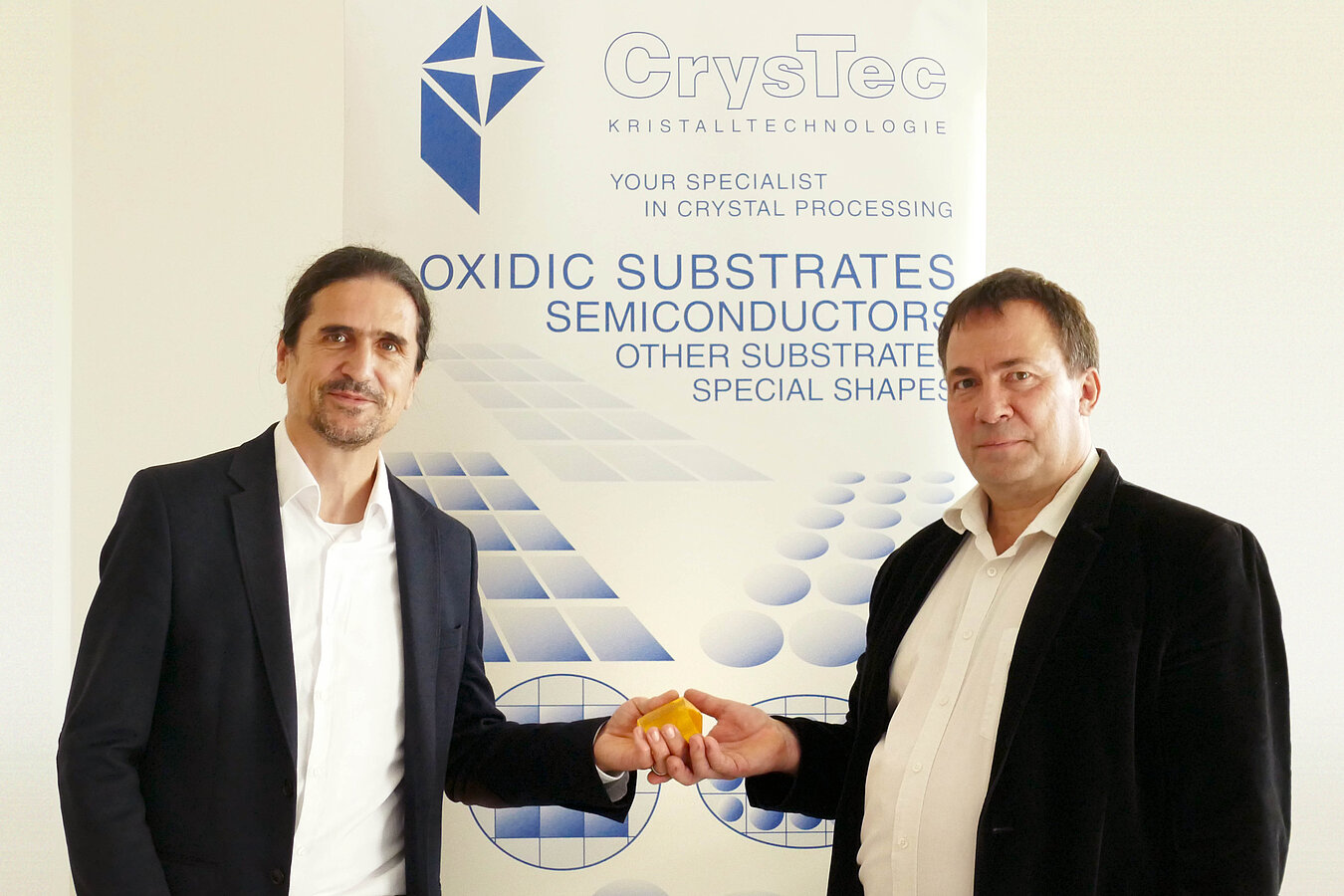In a groundbreaking collaboration, the Leibniz Institute for Crystal Growth (IKZ) and CrysTec GmbH have joined forces to facilitate the production of Ga₂O₃, a novel semiconductor material with immense potential for power electronics research and development. The partnership aims to make this cutting-edge material accessible to researchers from both academia and industry.

During a ceremonial handover, Dr. Thomas Straubinger, Head of the Section 'Crystalline Materials for Electronics' at IKZ, presented a Ga₂O₃ crystal measuring 2 inches in diameter to Knut Peters, Managing Director of CrysTec GmbH. This symbolic event marked the commencement of the collaboration.
The transformation of energy grids, in tandem with the global shift from centralized power plants to decentralized energy generation, necessitates constant energy conversion. To convert direct current from sources such as solar plants into alternating current, efficient and reliable switches are paramount. These switches must allow electricity to flow smoothly without excessive energy losses and overheating. Similarly, for electric vehicles to achieve battery ranges of up to 1,000 kilometers, the power must be delivered to the motor without significant heat dissipation. To address these challenges, a new generation of power electronics is required, and gallium oxide (Ga₂O₃) is the key material for this advancement, explained Prof. Thomas Schröder, Director of IKZ.
Over the past 15 years, IKZ has dedicated extensive research and investigation to Ga₂O₃ as a semiconductor material. Its efficiency in power electronics applications outshines that of current industry favorites such as float-zone silicon, silicon carbide, and gallium nitride. Notably, IKZ is the sole institute in the European Union capable of producing single crystals of gallium oxide. Dr. Thomas Straubinger, Head of the IKZ Section 'Crystalline Materials for Electronics', emphasized the institute's expertise in plant engineering, crystal growth, and crystal analysis. However, IKZ still seeks to refine the process of cutting large-area substrates with precision from these single crystals, a crucial step to fully explore and optimize Ga₂O₃ for power electronics applications.
CrysTec, a medium-sized company headquartered in the Innovations-Park Wuhlheide. Through ongoing research projects and substrate preparations using IKZ's special crystals, CrysTec has maintained a strong relationship with IKZ for many years. Their collaboration in the field of Ga₂O₃ began a decade ago. Going forward, the partners will jointly develop and refine procedures to process IKZ's Ga₂O₃ crystals into wafers with up to 2 inches in diameter. Leveraging CrysTec's extensive worldwide distribution network, the material will be made available to universities, research institutes, and industry players. Knut Peters, Managing Director of CrysTec, recognized the significance of this collaboration, stating that it enables CrysTec to offer world-leading products for research and cutting-edge applications. Adding Ga₂O₃ to their portfolio is a significant step that provides market advantages.
The ongoing partnership between IKZ and CrysTec focuses on the development of advanced growth, processing, and epitaxy technologies for Ga₂O₃. They also aim to identify commercially viable substrate prototype specifications within the framework of the funded project 'GO-Wafer: Development of a technology for the production of standardized gallium oxide wafers with defined tilting from the [100] and [001] directions,' sponsored by the German Federal Ministry of Economics and Climate Protection (BMWK).
This collaboration perfectly aligns with IKZ's mission to not only produce and study new materials but to also make them widely accessible to the academic, university, and industrial communities. As a result of this partnership, the institute can now offer gallium oxide to the external market for the first time. Thomas Schröder emphasized the goal of involving as many research groups worldwide as possible, encouraging them to contribute their expertise to advance the understanding of gallium oxide.
The introduction of silicon carbide switches has already significantly increased the range of electric vehicles. If the promising research findings of IKZ and its partners are validated, gallium oxide could pave the way for the next breakthrough in electric vehicle range. Although the semiconductor is not currently available on the market, leading manufacturers and power electronics users are already expressing keen interest, displaying their proactive approach to securing potential innovations in advance.







